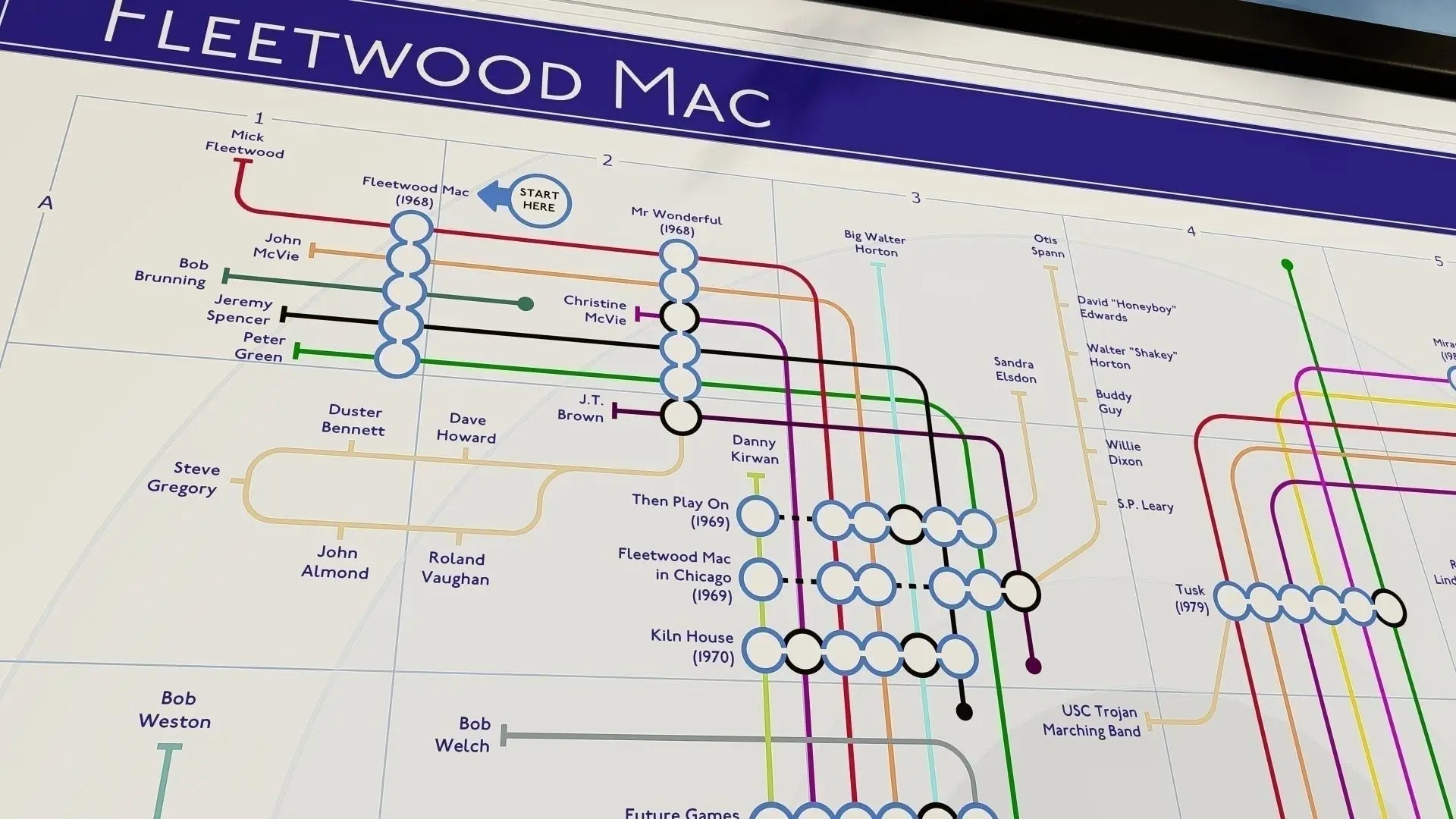
Fleetwood Mac Albums – A Complete Discography Guide
by Mike Bell
·
Fleetwood Mac is one of the most influential rock bands in music history. From their blues origins to their pop-rock dominance, their discography showcases an evolution that few bands can match. In this article, we will examine Fleetwood Mac's studio albums, highlighting their musical evolution and enduring legacy.
Fleetwood Mac’s discography spans multiple decades, with each album reflecting a different phase of their sound. For example, their early albums leaned heavily on blues, while later releases embraced pop-rock and experimental elements. As a result, their music continues to captivate audiences worldwide. My discography music map captures their studio work and collaborations.

Fleetwood Mac Studio Albums: Full Discography
1. Fleetwood Mac (1968)
- Notable Tracks: Shake Your Moneymaker, Long Grey Mare
- Style: British Blues
- Overview: This was Fleetwood Mac’s debut album, featuring the original lineup led by Peter Green. At the time, their sound was deeply rooted in blues, setting them apart from other British bands.
2. Mr. Wonderful (1968)
- Notable Tracks: Love That Burns, Stop Messin’ Around
- Style: Blues
- Overview: Fleetwood Mac’s second album continued their blues tradition. However, it introduced a more aggressive guitar sound and horn sections.
3. Then Play On (1969)
- Notable Tracks: Oh Well, Rattlesnake Shake
- Style: Blues Rock / Psychedelic Rock
- Overview: This was the last album featuring Peter Green. As a result, it showcased a mix of blues and progressive rock, marking a transition in the band’s style.
4. Kiln House (1970)
- Notable Tracks: Jewel-Eyed Judy, Station Man
- Style: Rock & Roll / Country Rock
- Overview: After Peter Green’s departure, Danny Kirwan took a leading role. Therefore, the album leaned more toward 1950s rock and country influences.
5. Future Games (1971)
- Notable Tracks: Future Games, Sands of Time
- Style: Soft Rock / Folk Rock
- Overview: This album introduced Bob Welch, bringing a more melodic and atmospheric sound to Fleetwood Mac. For instance, the title track is a dreamy departure from their blues roots.
6. Bare Trees (1972)
- Notable Tracks: Sentimental Lady, Bare Trees
- Style: Soft Rock / Blues Rock
- Overview: Featuring Welch’s songwriting, Bare Trees was well received. Moreover, it contained Sentimental Lady, which Welch later re-recorded as a solo hit.
7. Penguin (1973)
- Notable Tracks: Remember Me, Did You Ever Love Me
- Style: Rock / Folk
- Overview: The album featured Dave Walker, though his time with Fleetwood Mac was brief. Nevertheless, the album showcased further experimentation.
8. Mystery to Me (1973)
- Notable Tracks: Hypnotized, Emerald Eyes
- Style: Soft Rock / Blues Rock
- Overview: One of Bob Welch’s strongest contributions, this album leaned toward a more polished, radio-friendly sound. Consequently, it gained a cult following over time.
9. Heroes Are Hard to Find (1974)
- Notable Tracks: Come a Little Bit Closer, Bermuda Triangle
- Style: Soft Rock / Pop Rock
- Overview: This was Fleetwood Mac’s last album before the arrival of Stevie Nicks and Lindsey Buckingham. As a result, it marked the end of their transitional era.
The Classic Fleetwood Mac Era (1975–1987)
10. Fleetwood Mac (1975)
- Notable Tracks: Rhiannon, Landslide, Say You Love Me
- Style: Rock / Pop
- Overview: This was the first album featuring Stevie Nicks and Lindsey Buckingham. As expected, it became a huge success, launching Fleetwood Mac into mainstream fame.
11. Rumours (1977)
- Notable Tracks: Go Your Own Way, Dreams, The Chain, Don’t Stop
- Style: Rock / Soft Rock
- Overview: This album is considered one of the greatest of all time. Despite the band’s personal turmoil, Rumours produced some of their biggest hits.
12. Tusk (1979)
- Notable Tracks: Sara, Tusk, Think About Me
- Style: Experimental Rock / New Wave
- Overview: Instead of repeating Rumours, Fleetwood Mac took a more experimental approach. For instance, the title track incorporated a marching band.
13. Mirage (1982)
- Notable Tracks: Hold Me, Gypsy, Love in Store
- Style: Soft Rock / Pop
- Overview: This album returned to a more radio-friendly sound. Consequently, songs like Gypsy became fan favorites.
14. Tango in the Night (1987)
- Notable Tracks: Little Lies, Big Love, Seven Wonders
- Style: Pop Rock / Synth Rock
- Overview: Featuring 1980s production, this was the band’s biggest album of the decade. As a result, it produced multiple hit singles.
Fleetwood Mac’s Later Years (1990–2003)
15. Behind the Mask (1990)
- Notable Tracks: Save Me, Skies the Limit
- Style: Pop Rock
- Overview: With Rick Vito and Billy Burnette replacing Buckingham, the band’s sound changed. However, the album did not achieve the same level of success.
16. Time (1995)
- Notable Tracks: I Do, Winds of Change
- Style: Soft Rock / Adult Contemporary
- Overview: Featuring Bekka Bramlett and Dave Mason, this album marked a significant departure from Fleetwood Mac’s classic sound.
17. Say You Will (2003)
- Notable Tracks: Peacekeeper, Say You Will
- Style: Rock
- Overview: The first album without Christine McVie, Say You Will leaned on Nicks and Buckingham’s songwriting. Nevertheless, it showcased some strong moments.
Fleetwood Mac’s Legacy
Fleetwood Mac’s ability to reinvent themselves has ensured their longevity. As a result, they continue to inspire new generations of musicians. Additionally, their classic albums continue to be bestsellers, demonstrating their enduring appeal.
In conclusion, Fleetwood Mac is more than just a band—they are a musical institution. Regardless of lineup changes, their music continues to captivate audiences worldwide.
For more information about Fleetwood Mac’s influence on music history, please refer to this article. Learn more about their iconic albums at Fleetwood Mac’s official website.
What’s your favorite Fleetwood Mac album? Let me know in the comments! 🎶